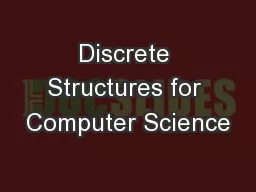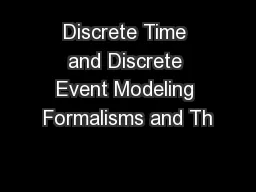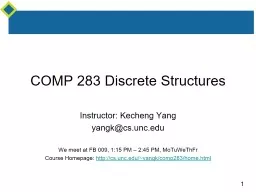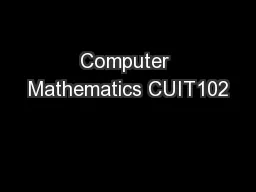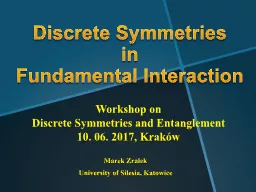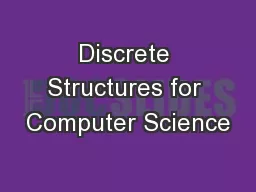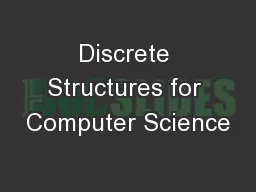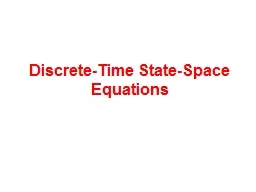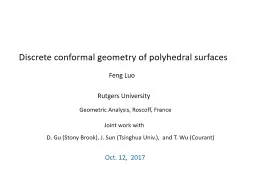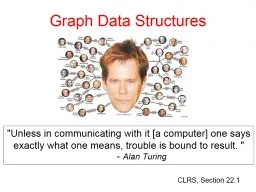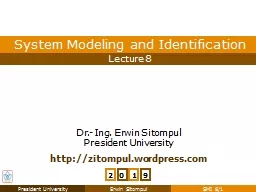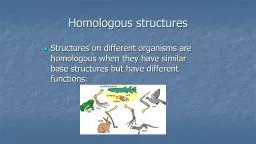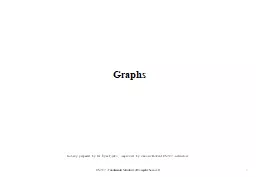PPT-Discrete Structures for Computer Science
Author : aaron | Published Date : 2018-09-21
Presented by Andrew F Conn Lecture 12 Solving Congruences and Cryptography October 10 th 2016 Today s Topics More on divisibility and remainders Modulo Inverse
Presentation Embed Code
Download Presentation
Download Presentation The PPT/PDF document "Discrete Structures for Computer Science" is the property of its rightful owner. Permission is granted to download and print the materials on this website for personal, non-commercial use only, and to display it on your personal computer provided you do not modify the materials and that you retain all copyright notices contained in the materials. By downloading content from our website, you accept the terms of this agreement.
Discrete Structures for Computer Science: Transcript
Presented by Andrew F Conn Lecture 12 Solving Congruences and Cryptography October 10 th 2016 Today s Topics More on divisibility and remainders Modulo Inverse Chinese Remainder Theorem. 5.1 Discrete-time Fourier Transform . Representation for discrete-time signals. Chapters 3, 4, 5. Chap. 3 . Periodic. Fourier Series. Chap. 4 . Aperiodic . Fourier Transform . Chap. 5 . Aperiodic . Dr. Feng Gu. Way to study a system. . Cited from Simulation, Modeling & Analysis (3/e) by Law and . Kelton. , 2000, p. 4, Figure 1.1. Model taxonomy. Modeling formalisms and their simulators . Discrete time model and their simulators . Instructor: Kecheng Yang. yangk@cs.unc.edu. We meet . at FB 009, 1:15 PM – 2:45 PM, . MoTuWeThFr. Course Homepage. : . http://cs.unc.edu/~. yangk/comp283/home.html. About Me. I am a fourth-year (fifth-year next fall) Ph.D. student.. Donna Musiyandaka. Master of Science in Computation (Oxford University). Bachelor of Business Studies and Computing Science (University of Zimbabwe). Bachelor of Science (. Hons. ) in Information Technology (IT) . Marek . Zrałek. University of Silesia, Katowice. Workshop on . Discrete Symmetries and Entanglement. 10. 06. 2017, . Kraków. Outline. Introduction. Discrete symmetries in Space Time and charge . c. Presented by: Andrew F. Conn. Adapted from: Adam J. Lee. Lecture #5. September 14. th. , 2016. Announcements. Homework #1 is due Wednesday. Today. ’. s topics. Introduction to Proofs. Rules of Inference. Presented . By:Andrew. F. Conn. Lecture #23: N-. ary. relations and Representations. November 30. th. , 2016. Announcements. This is the end of new material!!!. Thank you for sticking it out with me.. Equations. Outline. • Discrete-time state equation from . solution of . continuous-time state equation.. • Expressions in terms of . constituent matrices. .. • Example.. 2. Solution of State Equation. . . Feng Luo . . Rutgers University. D. Gu (Stony Brook), J. Sun (Tsinghua Univ.), and T. Wu (Courant). Oct. 12, 2017. Geometric Analysis, . Roscoff. , France. Graph Data Structures " Unless in communicating with it [a computer] one says exactly what one means, trouble is bound to result. " - Alan Turing CLRS, Section 22.1 Early Graph Theory Problem Leonhard Euler (1707 - 1783) . SYFTET. Göteborgs universitet ska skapa en modern, lättanvänd och . effektiv webbmiljö med fokus på användarnas förväntningar.. 1. ETT UNIVERSITET – EN GEMENSAM WEBB. Innehåll som är intressant för de prioriterade målgrupperna samlas på ett ställe till exempel:. Chapter 5. Discrete-Time Process Models. Discrete-Time Transfer Functions. The input to the continuous-time system . G. (. s. ) is the signal:. The system response is given by the convolution integral:. Homologous structures. Human Arm . Bat Wing . Whale Flipper. . Analogous. Structures . Similar functions but NOT structurally related. . Insects are arthropods and birds are vertebrates. . The wing of a bird and the wing of a butterfly are examples of . 1. Initially prepared by Dr. . İ. lyas. . Çiç. ekli. ; improved by various Bilkent CS202 instructors.. Graphs. Graphs are one of the unifying themes of computer science.. A graph G = (V. , . E) is defined by a set of .
Download Document
Here is the link to download the presentation.
"Discrete Structures for Computer Science"The content belongs to its owner. You may download and print it for personal use, without modification, and keep all copyright notices. By downloading, you agree to these terms.
Related Documents

